1997 BUICK CENTURY tow
[x] Cancel search: towPage 37 of 406
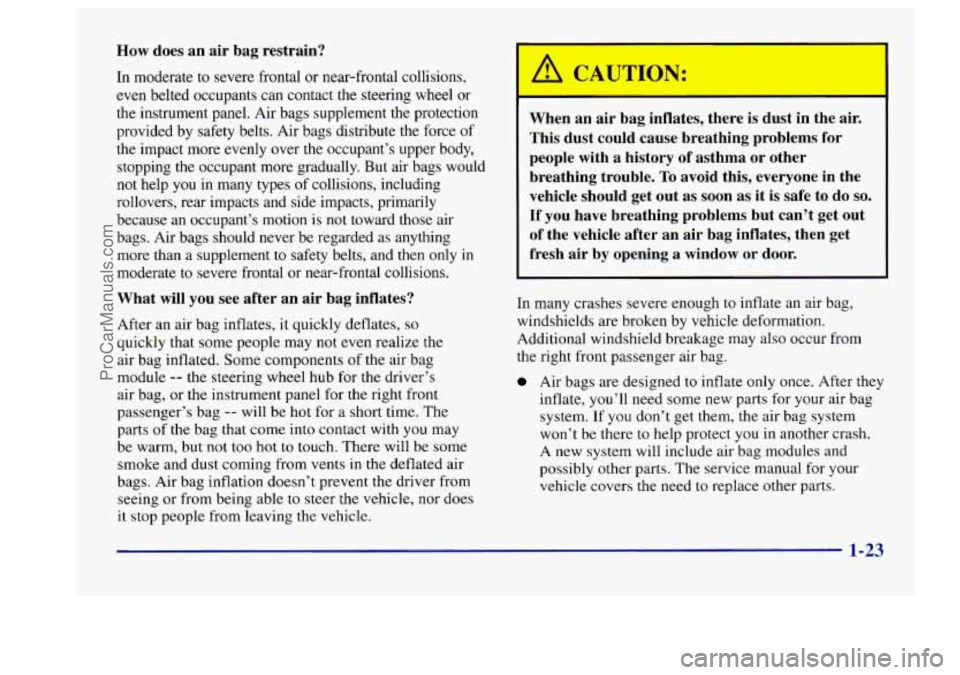
How does an air bag restrain?
In moderate to severe frontal or near-frontal collisions,
even belted occupants can contact the steering wheel or
the instrument panel. Air bags supplement the protection
provided by safety belts. Air bags distribute the force of
the impact more evenly over the occupant’s upper body,
stopping the occupant more gradually. But air bags would
not help you in many types of collisions, including
rollovers, rear impacts and side impacts, primarily
because an occupant’s motion is not toward those air
bags. Air bags should never be regarded as anything
more than a supplement
to safety belts, and then only in
moderate to severe frontal or near-frontal collisions.
What will you see after an air bag inflates?
After an air bag inflates, it quickly deflates, so
quickly that some people may not even realize the
air bag inflated. Some components of the air bag
module
-- the steering wheel hub for the driver’s
air bag, or the instrument panel for the right front
passenger’s bag
-- will be hot for a short time. The
parts of the bag that come into contact with you may
be warm, but not
too hot to touch. There will be some
smoke and dust coming from vents
in the deflated air
bags. Air bag inflation doesn’t prevent the driver from
seeing or from being able to steer the vehicle, nor does
it stop people from leaving
the vehicle.
I-
When an air bag i. ates, there is dust in the air.
This dust could cause breathing problems for
people with a history of asthma or other
breathing trouble.
To avoid this, everyone in the
vehicle should get out as soon as it
is safe to do so.
If you have breathing problems but can’t get out
of the vehicle after an air bag inflates, then get
fresh air by opening a window
or door.
In many crashes severe enough to inflate an air bag,
windshields are broken by vehicle deformation.
Additional windshield breakage may also occur from
the right front passenger air bag.
Air bags are designed to inflate only once. After they
inflate, you’ll need some new parts for your air bag
system. If
you don’t get them, the air bag system
won’t be there to help protect
you in another crash.
A new system will include air bag modules and
possibly other parts.
The service manual for your
vehicle covers the need to replace other parts.
1-23
ProCarManuals.com
Page 72 of 406
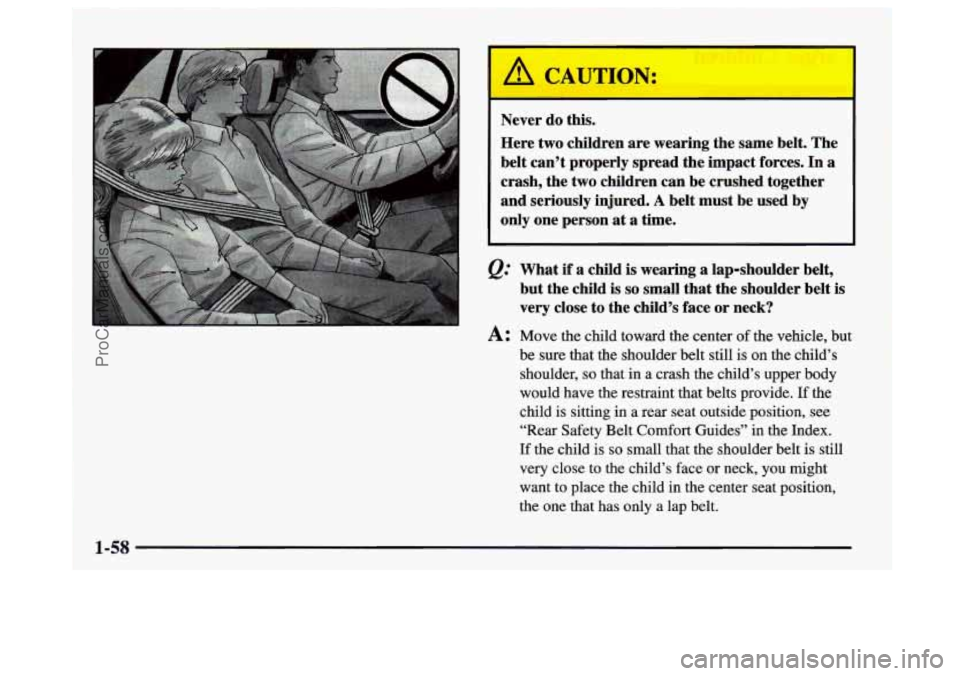
I
Never do this.
Here two children are wearing the same belt. The
belt can’t properly spread the impact forces.
In a
crash, the two children can be crushed together
and seriously injured.
A belt must be used by
only one person at a time.
Q: What if a child is wearing a lap-shoulder belt,
but the child
is so small that the shoulder belt is
very close to the child’s face or neck?
A: Move the child toward the center of the vehicle, but
be sure that the shoulder belt still is on the child’s
shoulder,
so that in a crash the child’s upper body
would have the restraint that belts provide. If the
child is sitting in a rear seat outside position, see
“Rear Safety Belt
Comfort Guides’’ in the Index.
If the child is so small that the shoulder belt is still
very close to the child’s face or neck, you might
want to place the child in the center seat position,
the one that has only a lap belt.
1-58
ProCarManuals.com
Page 93 of 406
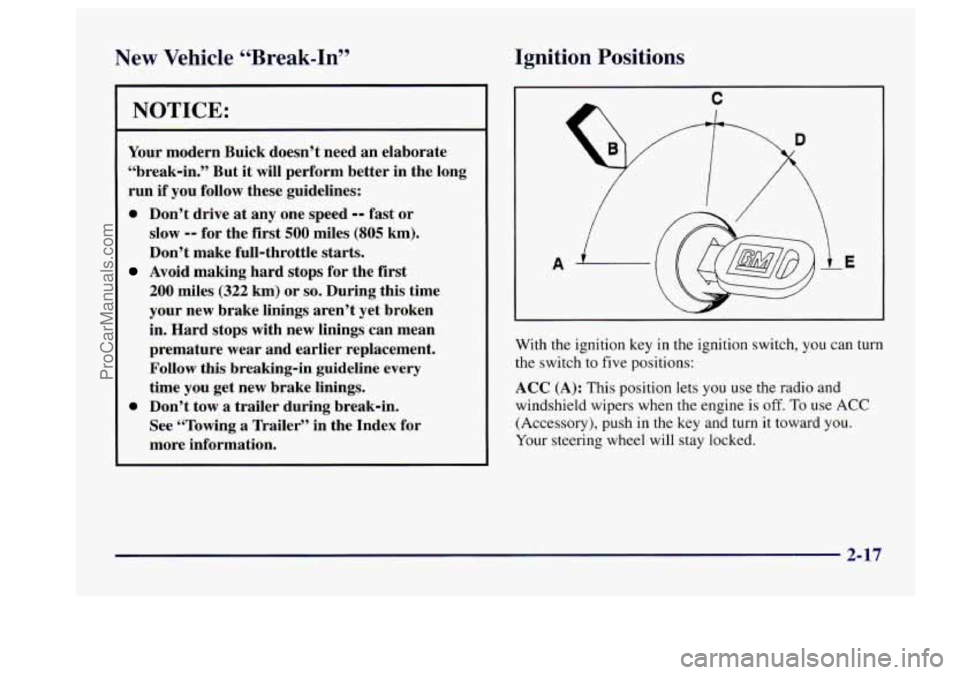
New Vehicle “Break-In”
NOTICE:
Your modern Buick doesn’t need an elaborate
“break-in.” But it will perform better in the long
run if you follow these guidelines:
0 Don’t drive at any one speed -- fast or
slow
-- for the first 500 miles (805 km).
Don’t make full-throttle starts.
200 miles (322 km) or so. During this time
your new brake linings aren’t yet broken
in. Hard stops with new linings can mean
premature wear and earlier replacement. Follow this breaking-in guideline every
time you get new brake linings.
See “Towing
a Trailer’’ in the Index for
more information.
Avoid making hard stops for the first
0 Don’t tow a trailer during break-in.
Ignition Positions
A L
With the ignition key in the ignition switch, you can turn
the switch
to five positions:
ACC
(A): This position lets you use the radio and
windshield wipers when the engine is off. To use
ACC
(Accessory), push in the key and turn it toward you.
Your steering wheel will stay locked.
2-17
ProCarManuals.com
Page 94 of 406
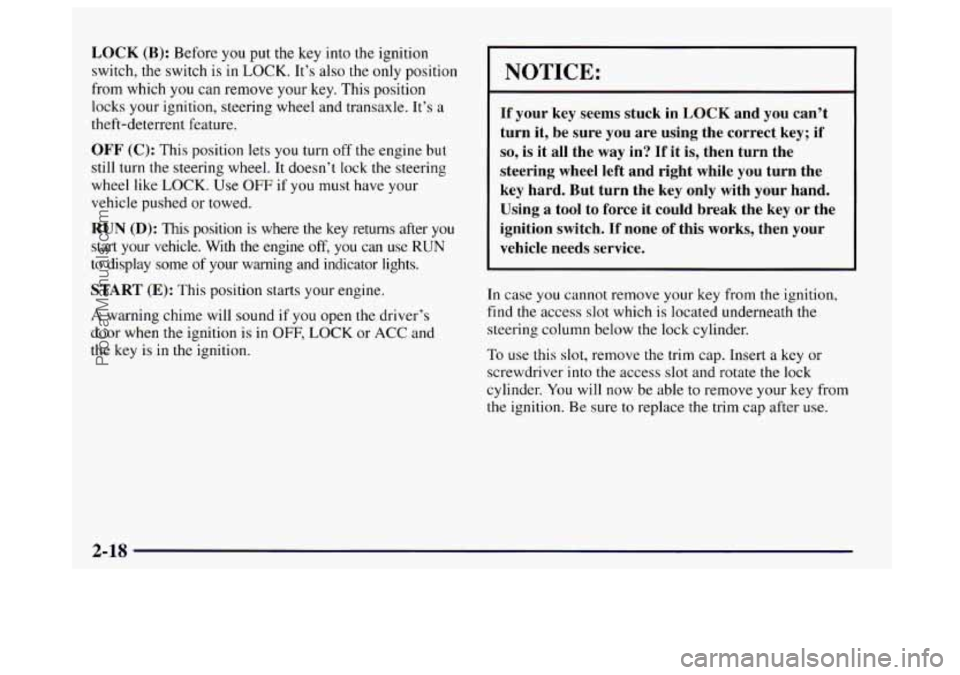
LOCK (B): Before you put the key into the ignition
switch, the switch is in
LOCK. It’s also the only position
from which you
can remove your key. This position
locks your ignition, steering wheel and transaxle. It’s
a
theft-deterrent feature.
OFF (C): This position lets you turn off the engine but
still turn
the steering wheel, It doesn’t lock the steering
wheel like
LOCK. Use OFF if you must have your
vehicle pushed or towed.
RUN (D): This position is where the key returns after you
start your vehicle. With the engine off, you can use RUN
to display some of your warning and indicator lights.
START (E): This position starts your engine.
A warning chime will sound if you open the driver’s
door when the ignition is
in OFF, LOCK or ACC and
the key is in the ignition.
NOTICE:
If your key seems stuck in LOCK and you can’t
turn it, be sure you are using the correct. key; if
so, is it all the way in? If it is, then turn the
steering wheel left and right while you turn the
key hard. But turn the key only with your hand.
Using a tool to force it
could break the key or the
ignition switch.
If none of this works, then your
vehicle needs service.
In case you cannot remove
your key from the ignition,
find the access
slot which is located underneath the
steering column below the lock cylinder.
To use this slot, remove the trim cap. Insert
a key or
screwdriver into the access slot and rotate the lock
cylinder.
You will now be able to remove your key from
the ignition. Be sure to replace the trim cap after use.
2-18
ProCarManuals.com
Page 96 of 406

2. If your engine won’t start (or starts but then stops), it
could be flooded with too much gasoline. Try
pushing your accelerator pedal all the way to the
floor and holding it there as you hold the key in
START for up to 15 seconds. This clears the extra
gasoline from the engine.
NOTICE:
Your engine is designed to work with the
electronics in your vehicle.
If you add electrical
parts or accessories, you could change the
way
the engine operates. Before adding electrical
equipment, check with your dealer.
If you don’t,
your engine might not perform properly.
If you ever have to have your vehicle towed, see
the part
of this manual that tells how to do it
without damaging your vehicle. See “Towing
Your Vehicle” in the Index.
Engine Coolant Heater (Option)
In very cold weather, 0” F (- 1 8 “C) or colder, the engine
coolant heater can help. You’ll get easier starting and
better fuel economy during engine warm-up. Usually,
the coolant heater should be plugged in a minimum
of
four hours prior to starting your vehicle.
2-20
ProCarManuals.com
Page 98 of 406
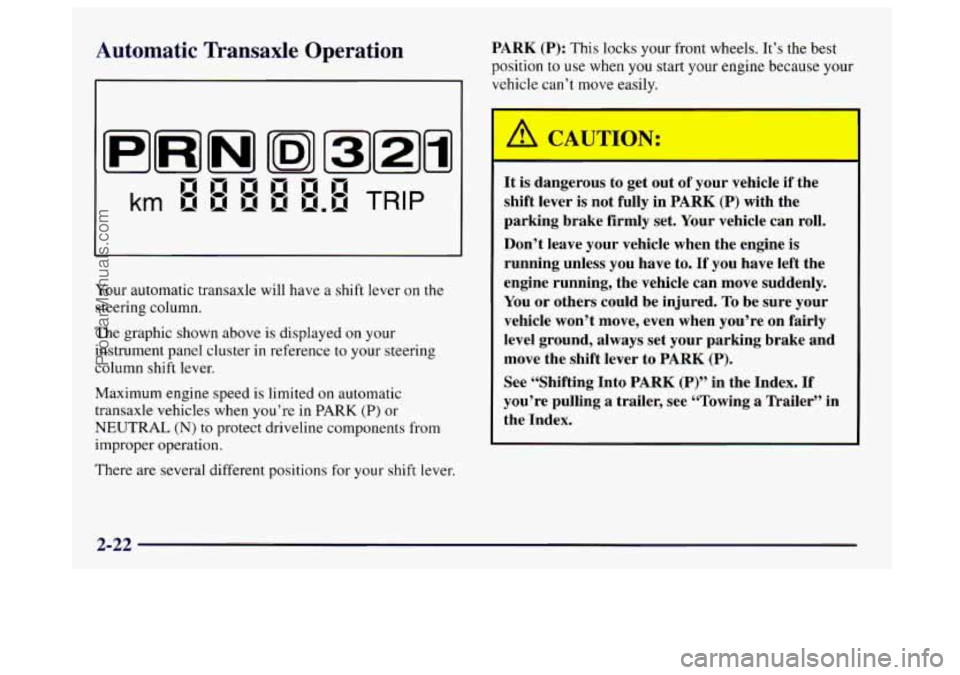
Automatic Transaxle Operation PARK (P): This locks your front wheels. It’s the best
position to use when you start your engine because your
vehicle can’t move easily.
Your automatic transaxle will have
a shift lever on the
steering column.
The graphic shown above is displayed on your
instrument panel cluster
in reference to your steering
column shift lever.
Maximum engine speed is limited on automatic
transaxle vehicles when you’re in
PARK (P) or
NEUTRAL (N) to protect driveline components from
improper operation.
There are several different positions for your shift lever.
L
CAUTIO,. :
It is dangerous to get out of your vehicle if the
shift lever is not fully in
PARK (P) with the
parking brake firmly set. Your vehicle can roll.
Don’t leave your vehicle when the engine is
running unless you have
to. If you have left the
engine running, the vehicle
can move suddenly.
You or others could be injured. To be sure your
vehicle won’t move, even when you’re on fairly
level ground, always set your parking brake and
move the shift lever to
PARK (P).
See “Shifting Into PARK (P)” in the Index. If
you’re pulling a trailer, see “Towing a Trailer” in
the Index.
2-22
ProCarManuals.com
Page 99 of 406
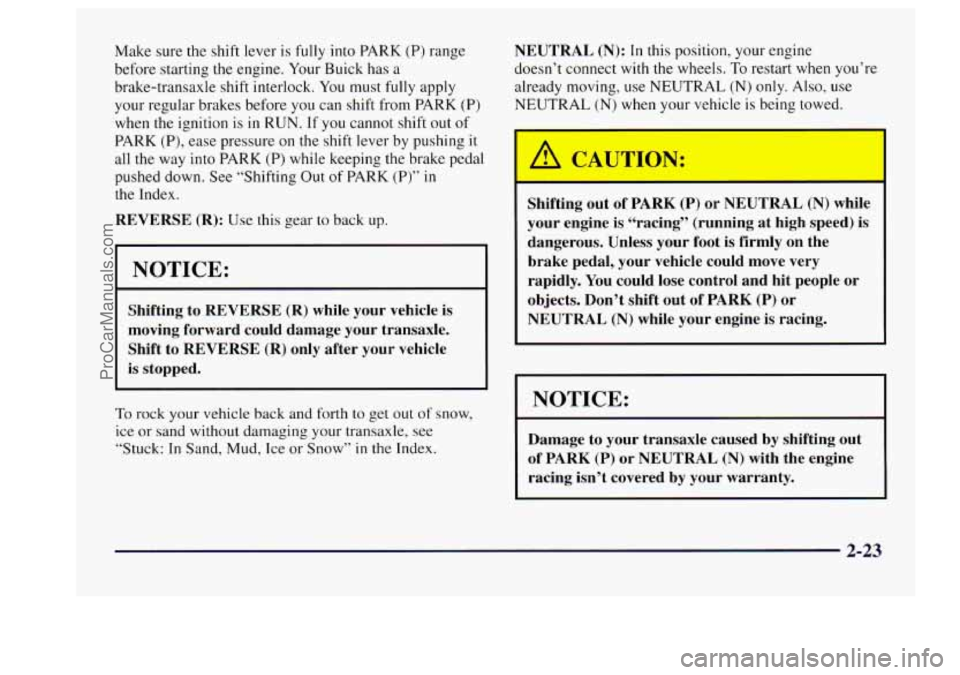
Make sure the shift lever is fully into PARK (P) range
before starting the engine. Your Buick has
a
brake-transaxle shift interlock. You must fully apply
your regular brakes before you can shift from PARK
(P)
when the ignition is in RUN. If you cannot shift out of
PARK (P), ease pressure on the shift lever by pushing it
all the way into PARK (P) while keeping the brake pedal
pushed down. See “Shifting Out of PARK
(P)” in
the Index.
REVERSE (R): Use this gear to back up.
NOTICE:
_____~ ~~ ~~ ~
Shifting to REVERSE (R) while your vehicle is
moving forward could damage your transaxle. Shift to
REVERSE (R) only after your vehicle
is stopped.
To rock your vehicle back and forth to get out of snow,
ice or sand without damaging your transaxle, see
“Stuck:
In Sand, Mud, Ice or Snow” in the Index.
NEUTRAL (N): In this position, your engine
doesn’t connect with the wheels.
To restart when you’re
already moving, use NEUTRAL
(N) only. Also, use
NEUTRAL
(N) when your vehicle is being towed.
Shifting out of
PARK (P) or NEUTRAL (N) while
your engine
is “racing” (running at high speed) is
dangerous. Unless your foot is firmly on the
brake pedal, your vehicle could move very
rapidly. You could lose control and hit people or
objects. Don’t shift out
of PARK (P) or
NEUTRAL (N) while your engine is racing.
NOTICE:
Damage to your transaxle caused by shifting out
of PARK (P) or NEUTRAL (N) with the engine
racing isn’t covered by your warranty.
2-23
ProCarManuals.com
Page 100 of 406
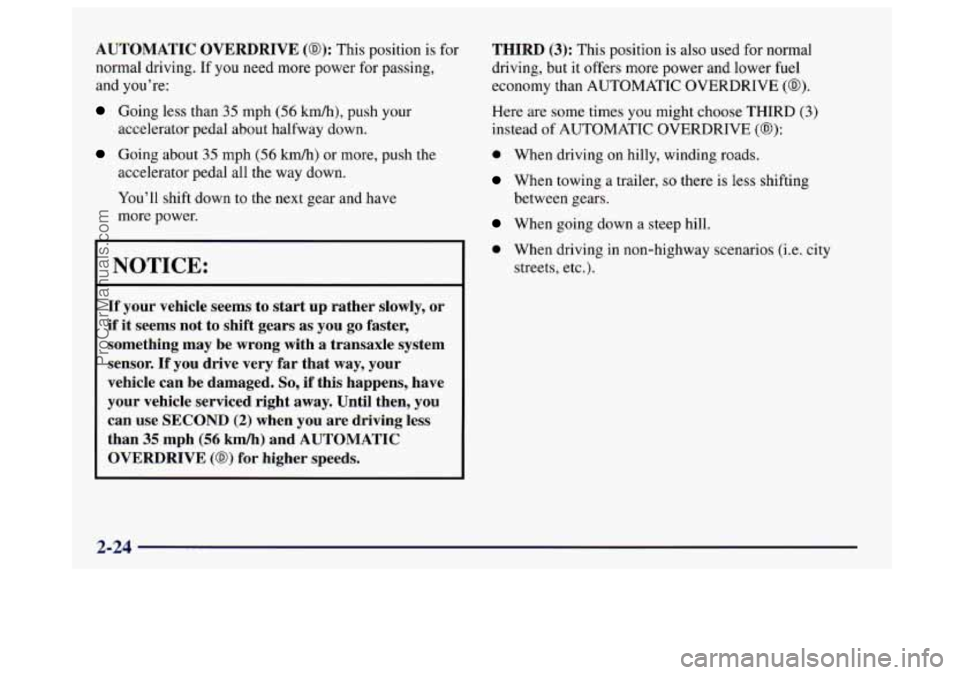
AUTOMATIC OVERDRIVE (@): This position is for
normal driving. If you need more power for passing,
and you’re:
Going less than 35 mph (56 km/h), push your
Going about 35 mph (56 kmh) or more, push the
accelerator
pedal about halfway down.
accelerator pedal all the way down.
You’ll shift down
to the next gear and have
more power.
NOTICE:
I
If your vehicle seems to start up rather slowly, or
if it seems not to shift gears as you go faster,
something may be wrong with a transaxle system
sensor.
If you drive very far that way, your
vehicle can be damaged.
So, if this happens, have
your vehicle serviced right away. Until then, you
can use
SECOND (2) when you are driving less
than
35 mph (56 kmh) and AUTOMATIC
OVERDRIVE (a) for higher speeds. THIRD
(3): This
position is also used for normal
driving, but it offers more power and lower fuel
economy than AUTOMATIC OVERDRIVE
(0).
Here are some times you might choose THIRD (3)
instead of AUTOMATIC OVERDRIVE (0):
0 When driving on hilly, winding roads.
When towing a trailer, so there is less shifting
When going down a steep hill.
0 When driving in non-highway scenarios (i.e. city
between
gears.
streets, etc.).
2-24
ProCarManuals.com